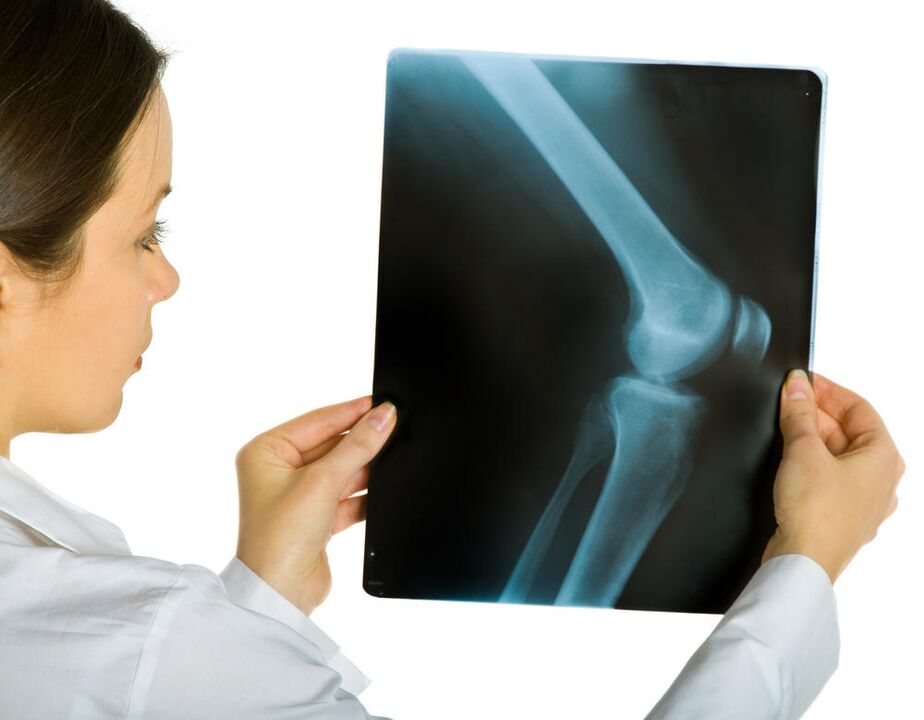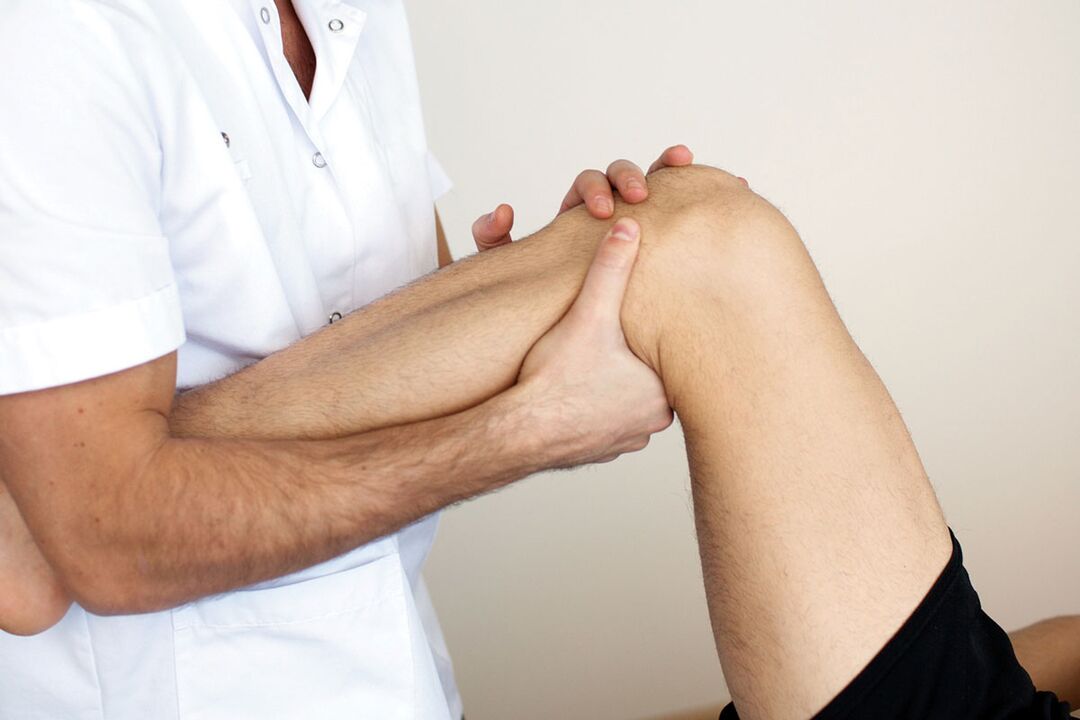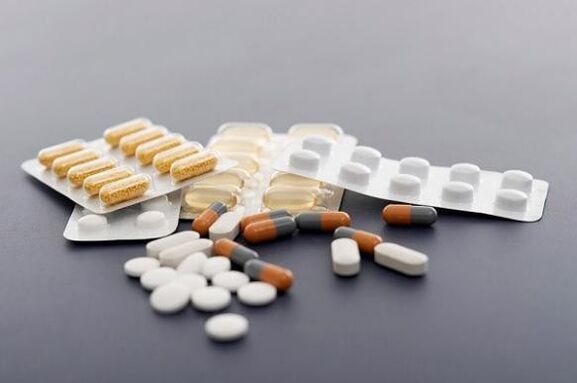Up to 20% of all people over the age of 25 are at risk of developing deforming osteoarthritis of the knee. The knee joint functions in the axial compression mode, therefore its articular surfaces are subjected to constant loads and are subject to degenerative changes in the hyaline cartilage.
%20and%20affected%20by%20arthrosis%20(left).jpg)
Prevalence
The pathology of the articular cartilage of a degenerative-dystrophic nature with the involvement of bone tissue, articular bag, ligaments and muscles in the process is called deforming arthrosis. In terminology there are synonyms:
- osteoarthritis;
- osteoarthritis;
- degenerative arthritis;
- arthrosis;
- hypertrophic arthritis;
In terms of frequency, damage to the knee comes immediately after the hip joint, so a stable phrase has formed: "gonarthrosis of the knee joint". The dependence of the frequency of the disease on age was studied:
| 26 - 44 years old | 5% of adults |
| 45 - 59 years old | 16. 70% |
| 60 - 69 years old | 12. 10% |
| 70 years and older | eleven% |
In all age groups, representatives of the fair sex quantitatively predominate. In them, arthrosis of the knee occurs 1. 2-1. 4 times more often than in men.
In the field of persistent disability, deforming arthrosis of the knee joint accounts for almost 30% of all causes of disability associated with articular pathology.
Classification of gonarthrosis

For reasons of development, the disease is divided into two large groups: primary and secondary. Primary arises without visible prerequisites. The secondary is preceded (or accompanied by) provoking factors:
- biomechanics disorders: injuries, excessive loads, developmental anomalies (dysplasia), skeletal pathology (scoliosis, flat feet), obesity;
- inflammatory processes: aseptic or infectious arthritis, frequent hemarthrosis in hemophilia;
- metabolic diseases: gout, hemochromatosis, Paget's disease;
- disorders of the endocrine glands: acromegaly, diabetes mellitus, disorders of the parathyroid glands;
- violations of adequate blood supply: varicose veins and post-thrombophlebitic syndrome, obliterating endarteritis, atherosclerosis of the vessels of the lower limb;
In medical practice, classification according to the severity of pathological changes is more useful. The assessment is made according to X-ray studies. The most popular clinical and radiological classification.
I stage
The picture shows a slight narrowing of the interarticular gap (a comparison is made with a healthy joint), the beginning of sclerosis of the pericartilaginous bone tissue. Clinically - pain occurs during walking or immediately after it, with prolonged standing. More pronounced when walking up stairs. Passes at rest. Gonarthrosis of the 1st degree does not greatly affect the function of the joint.
II stage
The joint space is 2-3 times narrower than normal. Sclerosis is more pronounced, osteophytes are found (spiky growths of bone tissue along the edges of the joint space and condyles). The pain is moderate, there are signs of muscle hypotrophy, lameness. The deformation of the knee in the frontal axis is visible. Gonarthrosis of the 2nd degree leads to a noticeable limitation of joint mobility.
III stage
Sclerosis of cartilaginous elements, deformation of articular surfaces. There are areas of subchondral necrosis, local osteoporosis. Cysts in adjacent bone tissue. The joint space is critically narrowed, sometimes not defined. Osteophytes of considerable size. Atrophy of the muscles of the thigh and lower leg, the joint is unstable, there is a pronounced deformity. Movement in the knee is sometimes impossible, contracture is formed. When moving - severe pain, lameness.
This approach to classification is convenient in that it allows assessing clinical manifestations in relation to organic changes. It gives the opportunity to choose a more effective treatment based on a comprehensive assessment of the state of the joint.
Development mechanism

The pathogenesis of any arthrosis goes through three stages:
- Damage to cartilage microstructures. Under the influence of any of the damaging factors, high-molecular compounds lose their strength and are enriched with water molecules. The ability of low molecular weight collagens to assemble into macromolecules is impaired. This leads to a decrease in the strength and durability of hyaline cartilage. Chondroprotectors counteract such phenomena.
- If the provoking factor is not eliminated, the weakening of cartilage components (glycosaminoglycans, proteoglycans) continues. This leads to the activation of recovery processes. Their power reserve is not particularly large, so this stage quickly passes into the next.
- Disruption of compensatory mechanisms leads to progressive destruction of articular cartilage, death of its cells - chondrocytes. Cartilage cracks extend to the underlying bone. The degree of detachment of the cartilaginous components increases, their defibration occurs, which leads to thinning of the hyaline membrane.
On the part of the bone, with deforming arthrosis of the knee joint, thickening (sclerosis) occurs, cysts and areas with uneven bone density appear. Hence, the deformation of the articular surfaces, the instability of the joint develops.
Diagnostics
The diagnosis is based on a set of data obtained as a result of a survey (anamnesis), medical examination, and instrumental research methods. The latter include radiographic examinations (CT, MRI), radioisotope (scintigraphy), arthroscopy.
Objective examination
It includes clarification of the patient's life history, circumstances preceding the development of gonarthrosis of the knee joint, collection of complaints and examination. In the process, the presence of provoking factors and the degree of their influence on the development of the disease is clarified.
At this stage, it is important to find out the condition of the second knee. If you miss bilateral gonarthrosis and focus only on the knee that worries you more, you can make a gross diagnostic mistake.
For this, functional tests should be carried out on two limbs at once. Attention is drawn to the pain of active and passive movements, sensitivity to palpation, crepitus (crunching) during extension and flexion. Chronic inflammatory processes lead to the appearance of a Becker cyst - a protrusion of the articular bag into the popliteal fossa, which can also be detected by palpation.
Instrumental Methods

The first is radiography. A picture of the knee in two projections allows for a preliminary assessment of the condition of the joint and determine the stage of the disease. The disadvantage of the method is that radiological signs occur later than the symptoms and morphological changes accompanying arthrosis of the knee joint.
In such cases, MRI (magnetic resonance imaging) helps. It is possible to determine the initial stages of degenerative changes in cartilage and bone structures, it is possible to assess the state of intra-articular ligaments, menisci. Scintigraphy for gonarthrosis of the knee joint provides data on the functional state.
Direct examination of the joint cavity is possible with arthroscopy.
For the unification of diagnostic data, the American College of Rheumatology proposed the following criteria:
- Age over 50 years.
- Stiffness in the joint in the morning, which persists for at least half an hour.
- Cracking, determined by movement (active and passive).
If these symptoms are accompanied by osteophytes found on x-ray and pain, it is highly likely that gonarthrosis of the knee joint occurs.
The initial stages of the disease may not be pronounced, therefore, it is necessary to carry out differential diagnostics with other articular pathologies, in which drugs pathogenetic for osteoarthritis (chondroprotectors) will be ineffective.
All possible measures should be taken not to confuse gonarthrosis with the following conditions:
Rheumatoid arthritis |
Onset at an early age, stiffness in the morning for more than 30 minutes, pain worse at rest and weaker in motion, rheumatoid nodules on the skin, concomitant lesions of internal organs, symptoms of intoxication (fever, sweating), C-reactive protein in blood tests. |
Crystal arthritis |
The pain is sharp, at night or in the morning; the skin over the diseased joint is edematous, red, hot; crystals on a microscopic examination of the synovial fluid, an increase in uric acid in the blood (with gout). |
Spondyloarthropathies |
Arthritis of other, unrelated joints (intercostal, lumbar joint); inflammatory processes in the tendons; damage to the cornea, skin, mucous membranes. |
In the International Classification of Diseases of the Tenth Revision (ICD 10), all these diseases are assigned the index "M", but a different numerical code.
These are fundamentally different pathological processes that require a professional approach to diagnosis and qualified treatment.
Therapeutic measures

If there is a disease, there must be ways to cure arthrosis of the knee joint. And they exist. Help can be provided in a variety of ways.
In the first place are the achievements of traditional medicine, based on a deep study of the causes and mechanism of the disease. Medical and surgical methods are used here. Competent treatment requires consistent and complex use of medications, physiotherapy methods and rehabilitation measures.
The second way is treatment with folk remedies. The effectiveness of these methods, to put it mildly, is questionable. But they are used, because it is possible to reduce the manifestations of the disease at home. Folk remedies can only be used as an addition to drug treatment or as part of complex therapy, it is imperative to obtain the consent of the attending physician!
medicinal help
This type of treatment includes the use of various medications. For medicinal effects, drugs from different groups are used:
- non-steroidal anti-inflammatory drugs, analgesics, opiates;
- symptomatic drugs of slow action (chondroprotectors);
- glucocorticoid hormones;
NSAIDs, rapid analgesics, opiates
Medicines of this group are designed to eliminate pain. Pain syndrome pretty much spoils the life of patients with arthrosis, its removal significantly improves the quality of human life. NSAIDs, anilides, non-narcotic and narcotic analgesics are capable of this.
A common drawback is the side effects. These drugs negatively affect the kidneys, the protective mechanisms of the gastrointestinal tract. An alternative that can reduce harmful manifestations are injections. Intramuscular administration damages the stomach less and accelerates the effect.
Due to side effects, drugs of this group are prescribed during exacerbations, careful dose selection is required.
The main advantage of NSAIDs is the many forms for local treatment (ointments, gels). Allows you to control the manifestations of the disease at home.
Analgesics of central action are prescribed for a short period, with the ineffectiveness of the other two groups. The most popular opiate is prescribed during an exacerbation, more often with bilateral gonarthrosis. These drugs are addictive. You can't take them on your own!
Symptomatic slow-acting drugs

The action of these substances is twofold: they have the ability to reduce pain (as NSAIDs) and contribute to the restoration of hyaline cartilage. Often they are called chondroprotectors.
The effect develops over several weeks (2-8) and persists after cancellation for 2-3 months.
In addition to chondroitin sulfate and glycosaminoglycans, this group includes preparations based on hyaluronic acid, compounds derived from avocado and soy.
The most studied and popular chondroprotectors (chondroitin sulfate and glycosaminoglycans) are ready-made components of articular cartilage. Well absorbed into the blood, form high concentrations in the joint cavity. To speed up the effect, injections can be made directly into the joint.
It has been proven that chondroitin sulfate, taken in courses for two years at a daily dosage of 800 mg, has a stabilizing effect on the joint space in gonarthrosis of the knee joint of the 2nd degree.
Avocado/soy compounds have anti-inflammatory effects. Due to the inhibition of collagenase (a decomposing enzyme), they significantly slow down the destruction of cartilage, increase the synthesis of "their own" collagen. They are also very well tolerated.
Hyaluronic acid derivatives are used in the form of intra-articular injections. These funds, like chondroprotectors, improve the functional state of the knee joint.
The mechanism of action of various drugs of slow symptomatic action is somewhat different, therefore, their combined use is recommended. A high level of safety allows you to take chondroprotectors for a long period without tangible harm to the body.
Glucocorticosteroids
The main action is anti-inflammatory. These funds are prescribed when NSAIDs are ineffective. Tablet forms also damage the lining of the stomach. There are forms for intra-articular injections.
They have numerous side reactions, so you should not abuse hormonal drugs for deforming arthrosis of the knee joint.
Group name |
Advantages |
Flaws |
|---|---|---|
NSAIDs, analgesics, opiates |
Quick effect, many forms for topical application. |
Side effects, unstable effect, dangerous for age-related patients, addiction occurs. |
Chondroprotectors |
They act pathogenetically, have a lasting effect, are non-toxic, there are forms for external and intra-articular use. |
Slow development of the effect. |
Hormones |
Quick effect where NSAIDs are not enough; forms for intraarticular administration. |
Side effects, unstable effect, long-term use is impossible. |
ethnoscience

At home, you can reduce the manifestations of the disease with folk remedies. There are a lot of recipes, but there are a few but:
- no clinical studies have been conducted;
- it is impossible to accurately dose the medicinal substance;
- indications are not clearly defined;
- the individual tolerance of folk remedies is not taken into account;
The advantages include a wide therapeutic range, a large selection for external use. Homemade compresses and tinctures, ointments are popular.
The effectiveness of home treatment can be substantiated by the fact that biologically active substances (gum, bile, infusions of medicinal plants) are used for preparation.
In addition, competent treatment with folk remedies begins with adherence to a diet, weight loss. This method alone, aimed at reducing the load on the joint, can reverse osteoarthritis of the knee joint of the 1st degree (the condition is young age, sufficient compensatory abilities). Healthy eating, in itself, stimulates the body's regenerative abilities. The diet includes: a slight feeling of hunger, vegetables, freshly squeezed juices. It is advisable to add low-fat jellies, jellies to the diet.
External means are very diverse. They mainly have an irritating and warming effect. The most studied components are bile, dimethyl sulfoxide and bischofite. Bile should be used medically, and not extracted independently from the corpse of an animal. Dimethyl sulfoxide is an analogue of a chemical warfare agent, mustard gas. Bischofite is a derivative of oil. That's the difference in origin.
All three drugs have an anti-inflammatory effect, however, at home they should be used only after consulting a doctor. These substances also have contraindications and application features.
We must not forget the placebo effect in the treatment of folk remedies.
The last thing I want to convey is that a person has one health. You should not completely rely on the apparent simplicity and cheapness of folk remedies. If you have already decided to try them, increase your attention to the sore joint. The progression of the disease against the background of treatment with folk remedies is a reason to reconsider the approach to therapy.
If osteoarthritis of the knee joint of grade 2 or higher is diagnosed, it is better not to mess with traditional medicine. Or postpone it for a period of remission. Unsatisfactory treatment is an indication for complex surgical intervention.
























